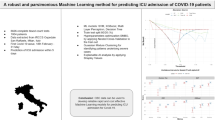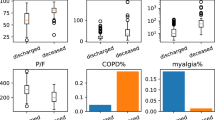Abstract
In this paper, we present the application of a Machine Learning (ML) approach that generates predictions to support healthcare professionals to identify the outcome of patients through optimization of treatment strategies. Based on Decision Tree algorithms, our approach has been trained and tested by analyzing the severity and the outcomes of 346 COVID-19 patients, treated through the first two pandemics “waves” in a tertiary center in Western Greece. Its’ performance was achieved, analyzing entry features, as demographic characteristics, comorbidity details, imaging analysis, blood values, and essential hospitalization details, like patient transfers to Intensive Care Unit (ICU), medications, and manifestation responses at each treatment stage. Furthermore, it has provided a total high prediction performance (97%) and translated the ML analysis to clinical managing decisions and suggestions for healthcare institution performance and other epidemiological or postmortem approaches. Consequently, healthcare decisions could be more accurately figured and predicted, towards better management of the fast-growing patient subpopulations, giving more time for the effective pharmaceutical or vaccine armamentarium that the medical, scientific community will produce.
Access this chapter
Tax calculation will be finalised at checkout
Purchases are for personal use only
Similar content being viewed by others
References
Chen, J., See, K.C.: Artificial intelligence for COVID-19: rapid review. J. Med. Internet Res. 22(10), e21476 (2020)
Vaishya, R., Javaid, M., Khan, I.H., Haleem, A.: Artificial Intelligence (AI) applications for COVID-19 pandemic. Diab. Metab. Syndr. 14(4), 337–339 (2020)
Mottaki, M.S., Mohammadipanah, F., Sajedi, H.: Contribution of machine learning approaches in response to COVID-19 infection. Inform. Med. Unlocked. 23, 100526 (2021)
Wang, B., et al.: AI-assisted CT imaging analysis for COVID-19 screening: building and deploying a medical AI system. Appl. Soft Comput. 98, 106897 (2021)
Mohanty, S., Rashid, M.H.A., Mridul, M., Mohanty, C., Swayamsiddha, S.: Application of artificial intelligence in COVID-19 drug repurposing. Diab. Metab. Syndr. 14(5), 1027–1031 (2020)
Naseem, M., Akhund, R., Arshad, H., Ibrahim, M.T.: Exploring the potential of artificial intelligence and machine learning to combat COVID-19 and existing opportunities for LMIC: a scoping review. J. Prim. Care Community Health 11 (2020). https://doi.org/10.1177/2150132720963634
Khemasuwan, D., Sorensen, J.S., Colt, H.G.: Artificial intelligence in pulmonary medicine: computer vision, predictive model and COVID-19. Eur. Respir. Rev. 29(157), 200181 (2020)
Marchevsky, A.M., Patel, S., Wiley, K.J., et al.: Artificial neural networks and logistic regression as tools for the prediction of survival in patients with stages I and II non-small cell lung cancer. Model Pathol. 11, 618–625 (1998)
Zampakis, P., et al.: Development of an intelligent system for the determination of rupture-related characteristics in intracranial aneurysms detected by Computed Tomography Angiography. Hellenic J. Radiol. 5(4), 8–17 (2020)
Burke, H.B., Goodman, P.H., Rosen, D.B., Henson, D.E., Weinstein, J.N., Harrell, F.E., Jr., et al.: Artificial neural networks improve the accuracy of cancer survival prediction. Cancer 79, 857–862 (1997)
Baxt, W.G.: Application of artificial neural networks to clinical medicine. Lancet 346, 1135–1138 (1995)
Revuelta, I., et al.: A hybrid data envelopment analysis-artificial neural network prediction model for COVID-19 severity in transplant recipients. Artif. Intell. Rev. 23, 1–32 (2021). https://doi.org/10.1007/s10462-021-10008-0
Bai, H.X., et al.: Performance of radiologists in differentiating COVID-19 from viral pneumonia on chest CT. Radiology 296, E46–E54 (2020)
Jiang, X., Coffee, M., Bari, A.: Towards an artificial intelligence framework for data-driven prediction of coronavirus clinical severity. Comput. Mater. Continua 63(1), 537–551 (2020)
Orsi, M.A., Oliva, G., Toluian, T., Pitino, C.V., Panzeri, M., Cellina, M.: Feasibility, reproducibility, and clinical validity of a quantitative chest X-ray assessment for COVID-19. Am. J. Trop. Med. Hyg. 103, 822–827 (2020)
Bragazzi, N.L., Dai, H., Damiani, G., Behzadifar, M., Martini, M., Wu, J.: How big data and artificial intelligence can help better manage the COVID-19 pandemic. Int. J. Environ. Res. Public Health 17, 3176 (2020)
Hurt, B., Kligerman, S., Hsiao, A.: Deep learning localization of pneumonia: 2019 coronavirus (COVID-19) outbreak. J. Thorac. Imaging 35(3), W87–W89 (2020)
Yan, L., et al.: An interpretable mortality prediction model for COVID-19 patients. Nat. Mach. Intell. 2(5), 283–288 (2020)
Carrer, L., et al.: Automatic pleural line extraction and COVID-19 scoring from lung ultrasound data. IEEE Trans. Ultrason. Ferroelectr. Freq. Control 67, 2207–2217 (2020)
Hassanien, A., Elghamrawy, S.: Diagnosis and prediction model for COVID19 patients response to treatment based on convolutional neural networks and Whale optimization algorithm using CT images, medRxiv2020.04.16.20063990 (2020)
Liang, W., et al.: Early triage of critically ill COVID-19 patients using deep learning. Nat. Commun. 11(1), 3543 (2020)
Wang, L., Lin, Z.Q., Wong, A.: Covid-net: a tailored deep convolutional neural network design for detection of covid-19 cases from chest x-ray images. Sci. Rep. 10, 1–2 (2020)
Bai, X., Fang, C., Zhou, Y., Bai, S., Liu, Z., Chen, Q.: Predicting COVID-19 malignant progression with AI techniques. medRxiv (2020)
Roy, S., et al.: Deep learning for classification and localization of COVID-19 markers in point-of-care lung ultrasound. IEEE Trans. Med. Imaging 39(8), 2676–2687 (2020)
Siegenthaler, W.: Differential diagnosis in internal medicine: from symptom to diagnosis, p. 1140 (2007)
Witten, I.H., Frank, E., Hall, M.A., Pal, C.J.: Data Mining: Practical Machine Learning tools and Techniques, 3rd edn. Morgan Kaufmann, Burlington (2011)
WEKA. Application of artificial neural networks to clinical medicine. Lancet q346, 1135–1138 (1995)
WEKA Machine Learning Group at the University of Waikato. http://www.cs.waikato.ac.nz/ml/index
https://www.euromomo.eu/graphs-and-maps#z-scores-by-country Accessed 02 Sep 2021
Sarica, A., Cerasa, A., Quattrone, A.: Random forest algorithm for the classification of neuroimaging data in Alzheimer’s disease: a systematic review. Front. Aging Neurosci. 9, 329 (2017)
Pfahringer, B.: Random model trees: an effective and scalable regression method. University of Waikato, New Zealand. http://www.cs.waikato.ac.nz/~bernhard
Sekhawat, V., Green, A., Mahadeva, U.: COVID-19 autopsies: conclusions from international studies. Diagn. Histopathol. 27(3), 103–107 (2021)
Wong, H.Y.F., et al.: Frequency and distribution of chest radiographic findings in COVID-19 positive patients. Radiology 296, E72–E78 (2020)
Author information
Authors and Affiliations
Corresponding author
Editor information
Editors and Affiliations
Rights and permissions
Copyright information
© 2022 ICST Institute for Computer Sciences, Social Informatics and Telecommunications Engineering
About this paper
Cite this paper
Maria, A., Dimitrios, V., Ioanna, M., Charalampos, M., Gerasimos, M., Constantinos, K. (2022). Clinical Decision Making and Outcome Prediction for COVID-19 Patients Using Machine Learning. In: Lewy, H., Barkan, R. (eds) Pervasive Computing Technologies for Healthcare. PH 2021. Lecture Notes of the Institute for Computer Sciences, Social Informatics and Telecommunications Engineering, vol 431. Springer, Cham. https://doi.org/10.1007/978-3-030-99194-4_1
Download citation
DOI: https://doi.org/10.1007/978-3-030-99194-4_1
Published:
Publisher Name: Springer, Cham
Print ISBN: 978-3-030-99193-7
Online ISBN: 978-3-030-99194-4
eBook Packages: Computer ScienceComputer Science (R0)




